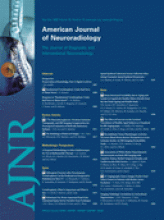Abstract
BACKGROUND AND PURPOSE: Selective white matter (WM) damage is a known sequela of mild hypoxic-ischemic (HI) injury in the neonatal rat model. The aim of this study was to evaluate longitudinally mild HI-induced WM damage (represented by the external capsule [EC]) by diffusion tensor MR imaging (DTI) and to correlate the findings with histology.
MATERIALS AND METHODS: Seven-day-old Sprague-Dawley rats (n = 19) underwent unilateral ligation of the left common carotid artery followed by hypoxia for 50 minutes to create mild HI injury. DTI was performed longitudinally at 5 time points from day 1 to day 90 postinjury (n = 19, 16, 13, 11, 9, respectively), and fractional anisotropy (FA), trace, radial diffusivity (λ⊥), and axial diffusivity (λ//) of the injury and control contralateral ECs were quantified. Rats were randomly sacrificed (n = 15, in total), and the corresponding ECs were stained with hematoxylin-eosin, Luxol fast blue (LFB), and neurofilament (NF) to evaluate morphologic changes, amount of myelin, and axonal count at every time point. A paired t test was applied to evaluate statistical differences between both ECs, and the Pearson correlation test was used to evaluate the relationships between DTI indices and histologic evaluations. In addition, longitudinal changes in DTI indices and histologic evaluations were analyzed by a linear mixed model and an analysis of variance test, respectively.
RESULTS: We demonstrated significantly decreased FA, increased λ⊥, and similar λ// in the injury compared with the control EC, which was persistent through all time points. Histologic evaluation by LFB and NF staining showed reduced myelin stain intensity in the injury EC and similar axonal counts in both ECs. Longitudinally, there was an increase in FA, a decrease in λ⊥ and trace, and stability in λ// in both ECs. Also, there was progressive reduction in the differences in FA, trace, and λ⊥ between the injury and control EC, especially between day 1 and day 7 postinjury and in tandem with changes in myelin stain. FA was significantly correlated with myelin stain (r = 0.681, P < .01) and axonal count (r = 0.673, P < .01), whereas λ⊥ was significantly correlated with myelin stain only (r = −0.528, P < .01), and λ//, with axonal count only (r = 0.372, P = .043).
CONCLUSIONS: Diffusion indices can reflect dysmyelination in mild HI injury, continual myelination of both injury and control ECs with growth, and the partial recovery of myelin postinjury. We propose that diffusion indices may be used as biomarkers to monitor noninvasively the longitudinal changes of mild HI-induced WM damage.
- Copyright © American Society of Neuroradiology












